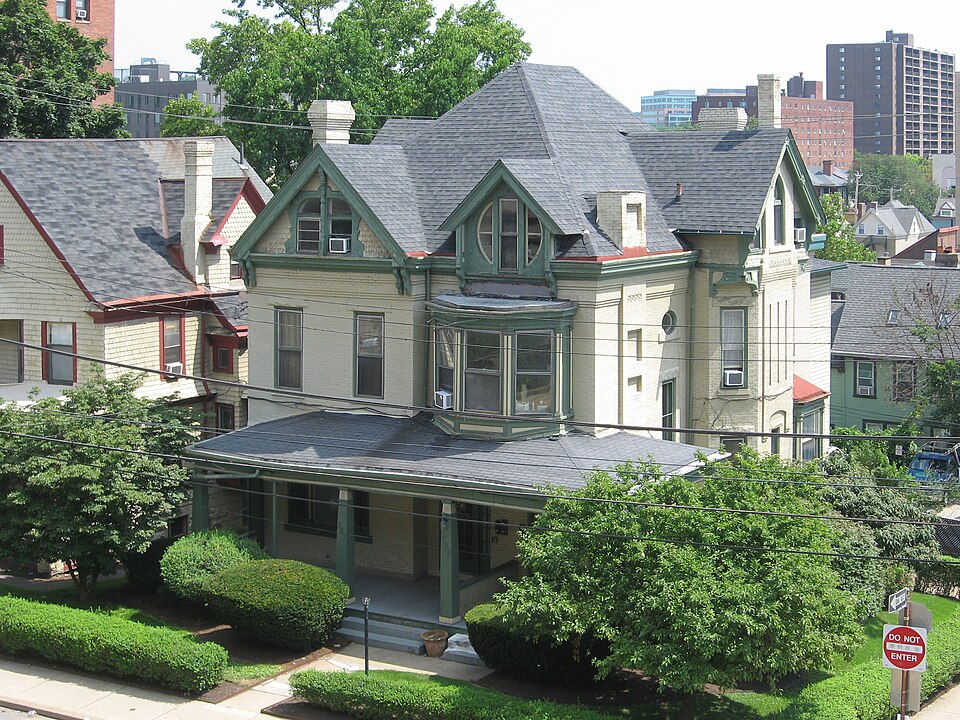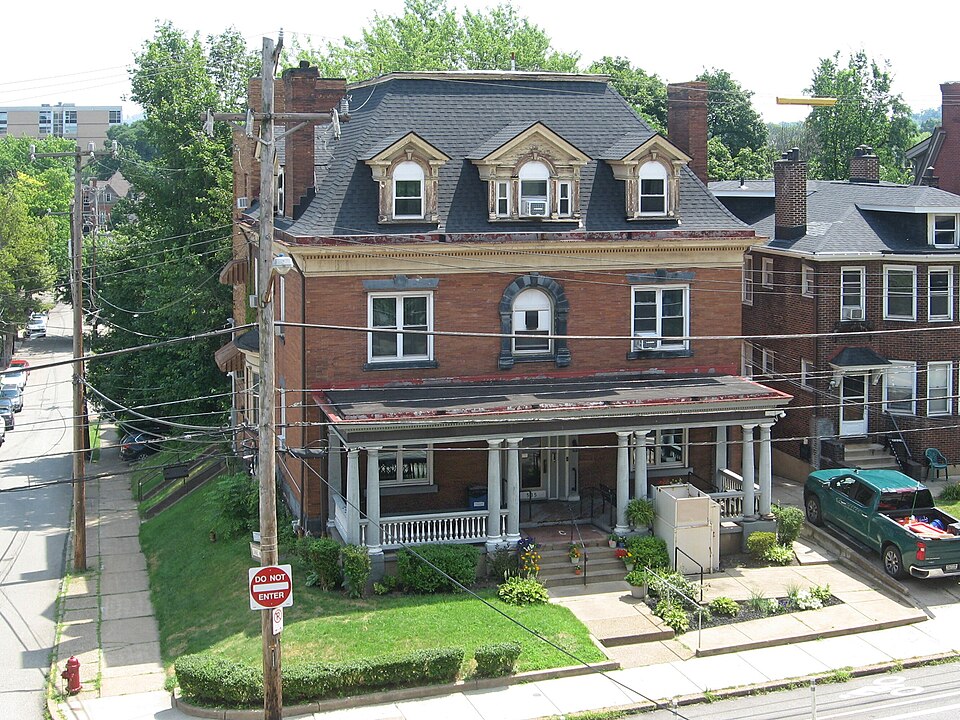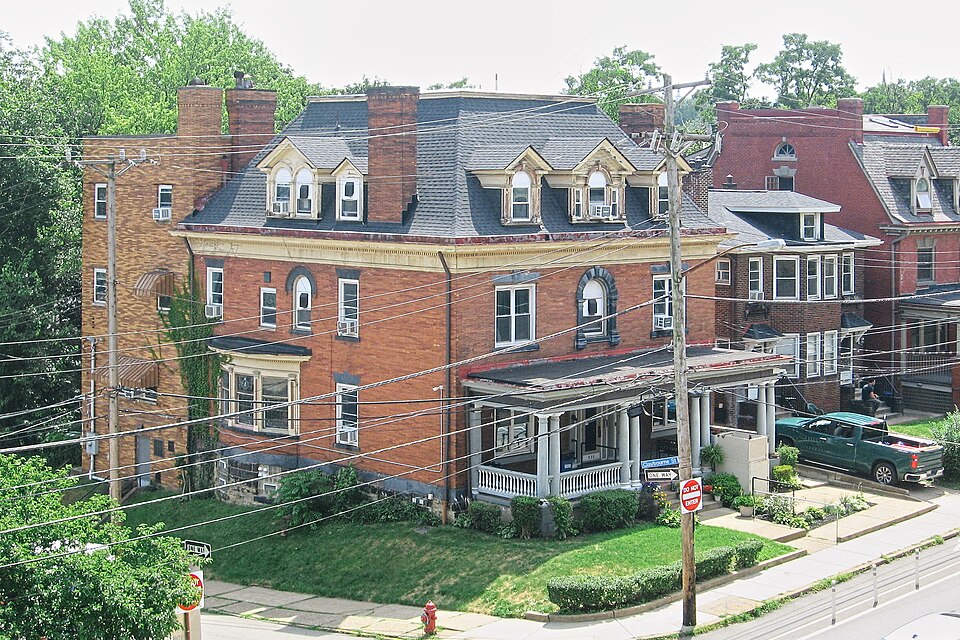
Double houses on Beechwood Boulevard in Greenfield, seen from the Murray Avenue Bridge.
Comments

Double houses on Beechwood Boulevard in Greenfield, seen from the Murray Avenue Bridge.

An unusually well-preserved small foursquare house that is charming and handsome in its way, in spite of being an architectural muddle. If you try to judge it by any standard of symmetry or proportion, you will quickly conclude that nothing is in the right place. But even after those thoughts have run through your mind, you are likely to think that somehow, in defiance of all correctness, it is a good-looking house.



Once again our frequent correspondent David Schwing has spotted something important and delightful: a previously unidentified work by Elise Mercur, Pittsburgh’s first female architect. It’s been sitting right there in the open, but nothing on the Internet has pointed out its significance.

Mercur was a fascinating character. At a time when women as architects were almost unheard of, she was getting big commissions and supervising crews of men who knew they had better not cross her. (See the picture above: would you want to get that look from your boss?)
She first came to national attention when she beat twelve other competitors with her design for the Woman’s Building at the Cotton States and International Exposition in Atlanta in 1895. The decision of the committee was unanimous: she blew the other competitors away.


These renderings were printed in a big architectural magazine, which picked them up from another big architectural magazine. They were also front-page news in Atlanta, and of course in Pittsburgh. The Inland Architect and News Record accompanied them with this brief introduction to the architect:
Miss Elise Mercur, architect, Pittsburgh, Pennsylvania. Of thirteen designs submitted, hers was considered of the highest merit and was accepted. As a preparation for her professional life Miss Mercur studied four years at the Philadelphia Academy of Fine Arts and subsequently continued her artistic studies in Germany. The lady has been a resident of Pittsburgh for four years and has been engaged upon practical architectural work in the office of Architect Thomas Boyd, whose foreman she now is. Miss Mercur assisted in the preparation of the plans for the new city Poor Buildings at Marshalsea and superintended their erection.
Thomas Boyd was a very prosperous architect in those days, and we must give him credit for recognizing ability when he saw it. It took courage to make a woman his construction foreman, but Mercur was up to the task.
Soon she had a prospering practice of her own, and she insisted on being in every way equal to a male architect.
For doing men’s work I always insist upon getting men’s prices. I never accept an assignment for less than 5 per cent. I never have any trouble. Contractors who have worked under me know that I won’t stand any ‘monkeying’ and do not try to fool me with poor material, careless work, &c. While I am willing to do what is right, I generally make them live up to the specifications, and any work done improperly has to be gone over again. (Mercur quoted in “Pittsburg’s Woman Architect,” New York World, January 9, 1898.)
Much of her work was academic—dormitories and classroom buildings for colleges. And that explains why most of it is gone. College presidents hate old buildings, because they stand in the way of big donors’ vanity projects, and college presidents are generally hired for their ability to round up big donors, not for their sensitivity to the architectural heritage of the campus. As far as we know, all of Mercur’s academic buildings have been demolished, some fairly recently. In fact, until a little while ago the only remaining building by Mercur known to exist was St. Paul’s Episcopal Church in the Hill District. But now we have a fine house whose identification rests on solid ground.

Dr. William H. Mercur has purchased a choice plot on Fifth avenue, opposite Lilac street, as a site for a new home. The lot measures 50×200 feet, and it belonged to Charles D. Callery. The price paid was $10,000 cash, or $200 a foot. Mrs. Elsie Mercur-Wagner is making plans for a $15,000 brick dwelling which is to be erected on the property within the next few months. (“Real Estate Transactions,” Pittsburg Press, April 27, 1900, p. 14.)
By this time Mercur was married and using the name Wagner along with her own. We may point out in passing that the name “Elise” was unusual enough that almost half the construction listings misspell it as “Elsie.” Dr. William H. Mercur was her brother, and we imagine he was quite pleased with the house his sister built for him.
“Lilac Street” in the listing is now St. James, and the location “opposite Lilac street” makes the house easy to find. Plat maps shortly after the house was built show it as belonging to M. S. Mercur (probably William’s wife; property was often put in the name of the wife). In 1923, it still belonged to M. S. Mercur. It is on the side of Fifth Avenue that is counted as Squirrel Hill by city planning maps, but traditionally both sides of the street were “Shadyside,” and the Mercurs were rubbing elbows with some very rich people in the Shadyside millionaires’ row.



By comparing this lot with the one next to it, we can see that the lot level was originally above the garage doors. The front yard has been dug away to make space for driveway and garages. Much of the distinctive detail of the house has been preserved, however, and we hope the owners realize that they possess a rare treasure.

A house in a dignified version of the Queen Anne style, but still with plenty of picturesque details, which take on added picturesqueness in sunset light.

The elaborate woodwork and shingles in the gables have been preserved.


A pattern of stock terra-cotta tiles set in the wall may have taken the place of a filled-in window.

Fifth Avenue in Shadyside was the most famous of the millionaires’ rows in Pittsburgh. But there were some more modest houses as well—“modest” being a comparative term here. Some predated the arrival of the millionaires, and some were beyond the main stretch of mansions. Many have been replaced by postwar apartment buildings, but a number of these houses survive. A while ago, Father Pitt took an evening stroll on Fifth Avenue to have a look at some of them. Above, a wood-frame Queen Anne mansion with picturesque protrusions in all directions.

A center-hall house in the turn-of-the-twentieth-century interpretation of Georgian style.

Another center-hall house of the sort old Pa Pitt would call a center-hall foursquare. Walking around to the side reveals a fat turret that must add to the interest of the interior.


Another Georgian house, though the Georgian era was lamentably ignorant of buff Kittanning brick.


From the old days, before the millionaires, here is a wide I-house whose main part seems to have been built before 1872.

We saw these houses last fall on a dim and rainy evening, and at that time we explained what little we knew about their history. Here are the ones on Beeler Street in bright sunshine.




Oakdale was a prosperous little town, as we can see by these houses in a variety of styles, all on the same street. It is still a fairly prosperous town today, and most of these houses have been kept up and altered in various ways that suited their inhabitants over the years. We present them without further comment, except to say that, if you come away with the impression that the back streets of Oakdale are very pleasant, your impression is correct.











Here’s a house in an eclectic style made up of bits of other eclectic styles, but they all fit together well. The heavy arches picked out in darker brick remind us of the Rundbogenstil, a word we like to say as often as possible; but the irregular picturesque arrangement of parts takes inspiration from the style that, in defiance of history, was called Queen Anne.


The turret has a well-preserved witch’s cap and a rim of foliage scrollwork.

The oriel and the porch pediment are both decorated with grotesque foliage ornaments.


The house next door is a duplicate, but reversed.

Finally, a house that shares the same general shape, but is distinguished by its shingly top with curved surfaces and ornamental swags and foliage picked out in contrasting paint.

Like many Shadyside houses, this one has automobiles burrowing under the porch.

Old Pa Pitt enjoys pointing out how architects and builders have approached the problem of making cheap housing attractive. These three houses face Friendship Park, where they sit among elaborate apartment buildings and much grander houses. They are very small and quite cheap. Yet because someone put effort into the design, they do not bring down the tone of the neighborhood. Instead, they contribute to a delightful sense of variety.


Parking garages sometimes give us good views of the surrounding buildings, and no one questions your right to be there as long as you look respectable enough. (The powdered wig helps.) Here are three interesting houses on Aiken Avenue seen from the Shadyside Hospital garage. First, an unusually well-preserved Shingle-style house with a lush crop of shingles.

This Queen Anne house has been turned into seven apartments, to judge by counting mailboxes and doorbells.


Finally, this mansion in the turn-of-the-twentieth-century interpretation of Colonial style has grown an apartment building in its back yard, a disease to which some old houses are subject in urban neighborhoods. It appears on Google Maps as a “community correction center,” so if you make a mistake in typing you can probably come here to have it corrected professionally. Old Pa Pitt prefers to make his own corrections, but he is glad there is a service for people who need it.
